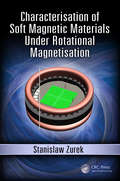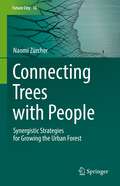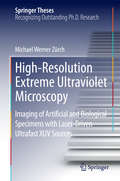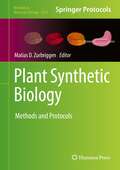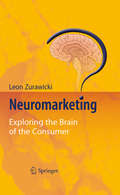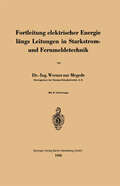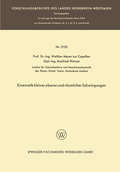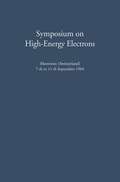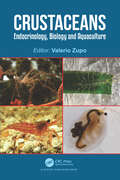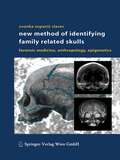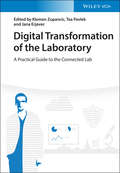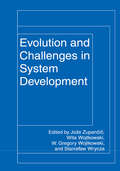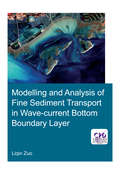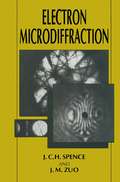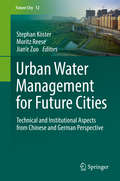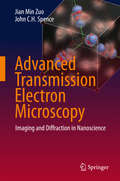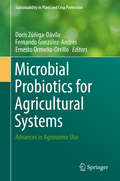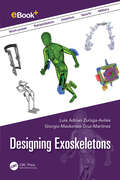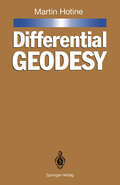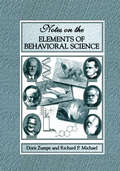- Table View
- List View
Characterisation of Soft Magnetic Materials Under Rotational Magnetisation
by Stanislaw ZurekThe book presents practical aspects related to the measurement of rotational power loss in soft magnetic materials. The book furthermore focuses on practical aspects of performing such measurements, the associated difficulties as well as solutions to the most common problems. Numerous practical aspects, hands-on experience, and most commonly encountered pitfalls are heavily discussed in the book. The text begins with introduction to magnetism, then follows with definitions of measurement methods of rotational power loss from physical viewpoint. Two chapters describe and detail the various sensors which can be employed for such measurements as well as all the aspects of designing, making, and using a magnetising apparatus. A synthesis of the likely optimal design of a magnetising apparatus is also given, preceded with the full reasoning based on all the research carried out to date. Characterisation of Soft Magnetic Materials Under Rotational Magnetisation serves as an excellent starting point for any student having to perform magnetic measurements under rotational magnetisation, but also under 1D, 2D or 3D excitation. Because the methods, sensors, and apparatus are extensively discussed it will also be a great reference for more senior researchers and experts in the field. There is a whole chapter devoted to analysis of measurement uncertainty. This subject is rarely published for magnetic measurements, which makes it more difficult for all researchers to understand the concepts and methodology used in uncertainty estimation. This chapter not only introduces the whole subject, but also provides multiple step-by-step examples which can be easily followed, from very simple cases to much more complex ones. All equations are presented with full SI units which greatly helps in practical application of the presented methodology. Each chapter is written in such a way that it can be studied on its own, so that the reader can focus only on the specific aspects, as required.
Connecting Trees with People: Synergistic Strategies for Growing the Urban Forest (Future City #16)
by Naomi ZürcherWritten from the perspective of an urban forester and certified arborist, the reader will have a basic understanding of what makes a tree a tree in context to the philosophical and cultural underpinnings of Urban and Community Forestry, and learn how to implement model, time-tested global green practices and initiatives derived from citizen science.
High-Resolution Extreme Ultraviolet Microscopy: Imaging of Artificial and Biological Specimens with Laser-Driven Ultrafast XUV Sources (Springer Theses)
by Michael Werner ZürchThis thesis describes novel approaches and implementation of high-resolution microscopy in the extreme ultraviolet light regime. Using coherent ultrafast laser-generated short wavelength radiation for illuminating samples allows imaging beyond the resolution of visible-light microscopes. Michael Zürch gives a comprehensive overview of the fundamentals and techniques involved, starting from the laser-based frequency conversion scheme and its technical implementation as well as general considerations of diffraction-based imaging at nanoscopic spatial resolution. Experiments on digital in-line holography and coherent diffraction imaging of artificial and biologic specimens are demonstrated and discussed in this book. In the field of biologic imaging, a novel award-winning cell classification scheme and its first experimental application for identifying breast cancer cells are introduced. Finally, this book presents a newly developed technique of generating structured illumination by means of so-called optical vortex beams in the extreme ultraviolet regime and proposes its general usability for super-resolution imaging.
Plant Synthetic Biology: Methods and Protocols (Methods in Molecular Biology #2379)
by Matias D. ZurbriggenThis volume provides methods on different aspects and applications on plants, algae, photosynthetic bacteria, synthetic construct design, and multiplex cloning. Chapters cover multiple aspects of synthetic metabolic, photosynthetic systems, metabolic and signaling pathways, advanced engineering of metabolic networks, isolation of organelles and co-culture of microorganisms, and methods for the on command manipulation of the relative stability of proteins. Written in the format of the highly successful Methods in Molecular Biology series, each chapter includes an introduction to the topic, lists necessary materials and reagents, includes tips on troubleshooting and known pitfalls, and step-by-step, readily reproducible protocols. Authoritative and cutting-edge, Plant Synthetic Biology: Methods and Protocols aims to be a useful resource for both researchers starting to explore novel experimental avenues as well as for experts willing to expand their portfolio of tools and strategies.
Neuromarketing: Exploring the Brain of the Consumer
by Leon ZurawickiOver the last 10 years advances in the new field of neuromarketing have yielded a host of findings which defy common stereotypes about consumer behavior. Reason and emotions do not necessarily appear as opposing forces. Rather, they complement one another. Hence, it reveals that consumers utilize mental accounting processes different from those assumed in marketers' logical inferences when it comes to time, problems with rating and choosing, and in post-purchase evaluation. People are often guided by illusions not only when they perceive the outside world but also when planning their actions - and consumer behavior is no exception. Strengthening the control over their own desires and the ability to navigate the maze of data are crucial skills consumers can gain to benefit themselves, marketers and the public. Understanding the mind of the consumer is the hardest task faced by business researchers. This book presents the first analytical perspective on the brain - and biometric studies which open a new frontier in market research.
Fortleitung elektrischer Energie längs Leitungen in Starkstrom- und Fernmeldetechnik
by W. Zur MegedeKinematik kleiner ebener und räumlicher Schwingungen (Forschungsberichte des Landes Nordrhein-Westfalen)
by Walther Meyer zur Capellen Manfred WernerSymposium on High-Energy Electrons: Montreux (Switzerland) 7th to 11th September 1964 Proceedings
by Adolf Zuppinger Guelfo G. PorettiOwing to the tremendously rapid development of the sciences publi cations of congresses and meetings are frequently out-of-date by the time they appear in print. We endeavoured to publish the report of the Sym posium in Montreux in as short a time as possible. In order to reduce the cost, the manuscripts hat to be confined to few pages at the most and it was absolutely necessary to limit the number of illustrations. For the Symposium in question we invited all those authors of whom we knew they were acquainted with the medicinal application of fast elec trons to take part in a discussion covering their particular field of interest. Other lectures were also admitted without exception. Unfortunately on account of various extrinsic reasons the time between the application to take part in the Symposium and the Meeting itself was far too short which fact prevented some well-known scientists from coming to Montreux. In cases where no speaker was to be found for a certain subject Bernese and Milano Institutes (Doc. Dr. med. P. L. CaVA) filled the gap whenever and wherever possible.
Crustaceans: Endocrinology, Biology and Aquaculture
by Valerio ZupoAnyone who attempts to study crustaceans soon realizes that there are many science fields involved. As a major subphylum of Arthropods—the largest phylum in the animal kingdom—crustaceans exhibit an extraordinary diversity of taxa, shapes, physiology and styles of life. These invertebrates play key ecological roles in all aquatic environments, while only a few species are adapted to sub-aerial and humid environments. Their evolutionary success is not only due to a wide set of morphological and biological adaptations, but also because of some key features, e.g., their peculiar endocrinology. In addition, crustaceans are characterized by chemical and optical sensors deserving attention because they play important biological roles, linked to chemical ecology issues, and their functioning is impaired by global changes and ocean acidification. Several crustaceans have critical roles in aquatic ecology (e.g., copepods in the plankton, amphipods and isopods in the benthos). Select species are technologically important as "models" for scientific research. Furthermore, aquaculture of several decapod crustaceans is important for providing high protein products to meet the need for nutrition. Understanding the physiology and ecology of crustaceans is important to fulfill these diverse purposes and practical applications. In this book, leading world scientists have pooled their excellence to provide vibrant and expert views of fundamental biological and physiological mechanisms involving crustaceans. To this end, a comprehensive view of crustacean endocrinology and reproductive ecology is provided, along with information about their molecular physiology, adaptations, aquaculture and welfare. In particular, we attempted to span the breadth of their adaptations, presenting behavioral and physiological peculiarities, considering key groups of crustaceans to describe general features and global biodiversity. This book is offered as a tool for students and scientists in various fields of physiological, ecological, biotechnological and aquacultural research.
Crustaceans: Endocrinology, Biology and Aquaculture
by Valerio ZupoAnyone who attempts to study crustaceans soon realizes that there are many science fields involved. As a major subphylum of Arthropods—the largest phylum in the animal kingdom—crustaceans exhibit an extraordinary diversity of taxa, shapes, physiology and styles of life. These invertebrates play key ecological roles in all aquatic environments, while only a few species are adapted to sub-aerial and humid environments. Their evolutionary success is not only due to a wide set of morphological and biological adaptations, but also because of some key features, e.g., their peculiar endocrinology. In addition, crustaceans are characterized by chemical and optical sensors deserving attention because they play important biological roles, linked to chemical ecology issues, and their functioning is impaired by global changes and ocean acidification. Several crustaceans have critical roles in aquatic ecology (e.g., copepods in the plankton, amphipods and isopods in the benthos). Select species are technologically important as "models" for scientific research. Furthermore, aquaculture of several decapod crustaceans is important for providing high protein products to meet the need for nutrition. Understanding the physiology and ecology of crustaceans is important to fulfill these diverse purposes and practical applications. In this book, leading world scientists have pooled their excellence to provide vibrant and expert views of fundamental biological and physiological mechanisms involving crustaceans. To this end, a comprehensive view of crustacean endocrinology and reproductive ecology is provided, along with information about their molecular physiology, adaptations, aquaculture and welfare. In particular, we attempted to span the breadth of their adaptations, presenting behavioral and physiological peculiarities, considering key groups of crustaceans to describe general features and global biodiversity. This book is offered as a tool for students and scientists in various fields of physiological, ecological, biotechnological and aquacultural research.
New Method of Identifying Family Related Skulls: Forensic Medicine, Anthropology, Epigenetics
by Zvonka Zupanic SlavecIf DNA cannot be isolated, don't give up the identification! The author has used for the same purpose methods ranging from physical anthropology to forensic medicine and especially a recent method of comparison of epigenetic traits, which proved to be very useful for the identification of family related skulls in connection with historical and other data. The kinship of 18 identified skulls (buried together in a family vault) is established by comparison of X-ray images of paranasal cavities (frontal and maxillary sinuses, orbital and nasal cavities), the shape and size of which are strongly genetically determined. The comparison also extends to numerous other epigenetic trait similarities on the skulls. It is recommended for: scientists working on human identification and studying heredity, forensic scientists, physical anthropologists, radiologists, stomatologists, paleopathologists, geneticists, historians and many others.
Digital Transformation of the Laboratory: A Practical Guide to the Connected Lab
by Klemen Zupancic Tea PavlekThis practical book in instrumental analytics conveys an overview of important methods of analysis and enables the reader to realistically learn the (principally technology-independent) working techniques the analytical chemist uses to develop methods and conduct validation. What is to be conveyed to the student is the fact that analysts in their capacity as problem-solvers perform services for certain groups of customers, i.e., the solution to the problem should in any case be processed in such a way as to be "fit for purpose". The book presents sixteen experiments in analytical chemistry laboratory courses. They consist of the classical curriculum used at universities and universities of applied sciences with chromatographic procedures, atom spectrometric methods, sensors and special methods (e.g. field flow fractionation, flow injection analysis and N-determination according to Kjeldahl). The carefully chosen combination of theoretical description of the methods of analysis and the detailed instructions given are what characterizes this book. The instructions to the experiments are so detailed that the measurements can, for the most part, be taken without the help of additional literature. The book is complemented with tips for effective literature and database research on the topics of organization and the practical workflow of experiments in analytical laboratory, on the topic of the use of laboratory logs as well as on writing technical reports and grading them (Evaluation Guidelines for Laboratory Experiments). A small introduction to Quality Management, a brief glance at the history of analytical chemistry as well as a detailed appendix on the topic of safety in analytical laboratories and a short introduction to the new system of grading and marking chemicals using the "Globally Harmonized System of Classification and Labelling of Chemicals (GHS)", round off this book. This book is therefore an indispensable workbook for students, internship assistants and lecturers (in the area of chemistry, biotechnology, food technology and environmental technology) in the basic training program of analytics at universities and universities of applied sciences.
Digital Transformation of the Laboratory: A Practical Guide to the Connected Lab
by Klemen ZupancicThis practical book in instrumental analytics conveys an overview of important methods of analysis and enables the reader to realistically learn the (principally technology-independent) working techniques the analytical chemist uses to develop methods and conduct validation. What is to be conveyed to the student is the fact that analysts in their capacity as problem-solvers perform services for certain groups of customers, i.e., the solution to the problem should in any case be processed in such a way as to be "fit for purpose". The book presents sixteen experiments in analytical chemistry laboratory courses. They consist of the classical curriculum used at universities and universities of applied sciences with chromatographic procedures, atom spectrometric methods, sensors and special methods (e.g. field flow fractionation, flow injection analysis and N-determination according to Kjeldahl). The carefully chosen combination of theoretical description of the methods of analysis and the detailed instructions given are what characterizes this book. The instructions to the experiments are so detailed that the measurements can, for the most part, be taken without the help of additional literature. The book is complemented with tips for effective literature and database research on the topics of organization and the practical workflow of experiments in analytical laboratory, on the topic of the use of laboratory logs as well as on writing technical reports and grading them (Evaluation Guidelines for Laboratory Experiments). A small introduction to Quality Management, a brief glance at the history of analytical chemistry as well as a detailed appendix on the topic of safety in analytical laboratories and a short introduction to the new system of grading and marking chemicals using the "Globally Harmonized System of Classification and Labelling of Chemicals (GHS)", round off this book. This book is therefore an indispensable workbook for students, internship assistants and lecturers (in the area of chemistry, biotechnology, food technology and environmental technology) in the basic training program of analytics at universities and universities of applied sciences.
Evolution and Challenges in System Development
by Joze Zupancic W. Gregory Wojtkowski Wita Wojtkowski Stanislaw WryczaThis book is a result of the Seventh International Conference on Information Sys tems Development-Methods and Tools, Theory and Practice held in Bled, Slovenia, Sep tember 21-23, 1998. The purpose of the conference was to address issues facing academia and industry when specifying, developing, managing, and improving information comput erized systems. During the past few years, many new concepts and approaches emerged in the Information Systems Development (ISD) field. The various theories, methods, and tools available to system developers also bring problems such as choosing the most effec tive approach for a specific task. This conference provides a meeting place for IS re searchers and practitioners from Eastern and Western Europe as well as from other parts of the world. An objective of the conference is not only to share scientific knowledge and in terests but to establish strong professional ties among the participants. The Seventh International Conference on Information Systems Develop ment-ISD'98 continues the concepts of the first Polish-Scandinavian Seminar on Current Trends in Information Systems Development Methodologies held in Gdansk, Poland in 1988. Through the years, the Seminar developed into the International Conference on In formation Systems Development. ISD'99 will be held in Boise, Idaho. The selection of papers was carried out by the International Program Committee. All papers were reviewed in advance by three people. Papers were judged according to their originality, relevance, and presentation quality. All papers were judged only on their own merits, independent of other submissions.
Modelling and Analysis of Fine Sediment Transport in Wave-Current Bottom Boundary Layer (IHE Delft PhD Thesis Series)
by Liqin ZuoThe evolution and utilization of estuarine and coastal regions are greatly restricted by sediment problems. This thesis aims to better understand fine sediment transport under combined action of waves and currents, especially in the wave-current bottom boundary layer (BBL). Field observations, experimental data analysis, theoretical analysis and numerical models are employed. Silt-dominated sediments are sensitive to flow dynamics and the suspended sediment concentration (SSC) increase rapidly under strong flow dynamics. This research unveils several fundamental aspects of silty sediment, i.e., the criterion of the incipient motion, the SSC profiles and their phase-averaged parameterization in wave-dominated conditions. An expression for sediment incipient motion is proposed for silt-sand sediment under combined wave and current conditions. A process based intra-wave 1DV model for flow-sediment dynamics near the bed is developed in combined wave-current conditions. The high concentration layer (HCL) was simulated and sensitivity analysis was carried out by the 1DV model on factors that impact the SSC in the HCL. Finally, based on the 1DV model, the formulations of the mean SSC profile of silt-sand sediments in wave conditions were proposed. The developed approaches are expected to be applied in engineering practice and further simulation.
Modelling and Analysis of Fine Sediment Transport in Wave-Current Bottom Boundary Layer (IHE Delft PhD Thesis Series)
by Liqin ZuoThe evolution and utilization of estuarine and coastal regions are greatly restricted by sediment problems. This thesis aims to better understand fine sediment transport under combined action of waves and currents, especially in the wave-current bottom boundary layer (BBL). Field observations, experimental data analysis, theoretical analysis and numerical models are employed. Silt-dominated sediments are sensitive to flow dynamics and the suspended sediment concentration (SSC) increase rapidly under strong flow dynamics. This research unveils several fundamental aspects of silty sediment, i.e., the criterion of the incipient motion, the SSC profiles and their phase-averaged parameterization in wave-dominated conditions. An expression for sediment incipient motion is proposed for silt-sand sediment under combined wave and current conditions. A process based intra-wave 1DV model for flow-sediment dynamics near the bed is developed in combined wave-current conditions. The high concentration layer (HCL) was simulated and sensitivity analysis was carried out by the 1DV model on factors that impact the SSC in the HCL. Finally, based on the 1DV model, the formulations of the mean SSC profile of silt-sand sediments in wave conditions were proposed. The developed approaches are expected to be applied in engineering practice and further simulation.
Electron Microdiffraction
by J.M. Zuo J.C.H. SpenceMuch of this book was written during a sabbatical visit by J. C. H. S. to the Max Planck Institute in Stuttgart during 1991. We are therefore grateful to Professors M. Ruhle and A. Seeger for acting as hosts during this time, and to the Alexander von Humbolt Foundation for the Senior Scientist Award which made this visit possible. The Ph. D. work of one of us (J. M. Z. ) has also provided much of the background for the book, together with our recent papers with various collaborators. Of these, perhaps the most important stimulus to our work on convergent-beam electron diffraction resulted from a visit to the National Science Foundation's Electron Microscopy Facility at Arizona State University by Professor R. H(lJier in 1988, and from a return visit to Trondheim by J. C. H. S. in 1990. We are therefore particularly grateful to Professor H(lJier and his students and co-workers for their encouragement and collaboration. At ASU, we owe a particular debt of gratitude to Professor M. O'Keeffe for his encouragement. The depth of his under standing of crystal structures and his role as passionate skeptic have frequently been invaluable. Professor John Cowley has also been an invaluable sounding board for ideas, and was responsible for much of the experimental and theoretical work on coherent nanodiffraction. The sections on this topic derive mainly from collaborations by J. C. H. S. with him in the seventies.
Urban Water Management for Future Cities: Technical and Institutional Aspects from Chinese and German Perspective (Future City #12)
by Jiane Zuo Moritz Reese Stephan KösterThis book features expert contributions on key sustainability aspects of urban water management in Chinese agglomerations. Both technical and institutional pathways to sustainable urban water management are developed on the basis of a broad, interdisciplinary problem analysis.
Advanced Transmission Electron Microscopy: Imaging and Diffraction in Nanoscience
by Jian Min Zuo John C.H. SpenceThis volume expands and updates the coverage in the authors' popular 1992 book, Electron Microdiffraction. As the title implies, the focus of the book has changed from electron microdiffraction and convergent beam electron diffraction to all forms of advanced transmission electron microscopy. Special attention is given to electron diffraction and imaging, including high-resolution TEM and STEM imaging, and the application of these methods to crystals, their defects, and nanostructures. The authoritative text summarizes and develops most of the useful knowledge which has been gained over the years from the study of the multiple electron scattering problem, the recent development of aberration correctors and their applications to materials structure characterization, as well as the authors' extensive teaching experience in these areas. Advanced Transmission Electron Microscopy: Imaging and Diffraction in Nanoscience is ideal for use as an advanced undergraduate or graduate level text in support of course materials in Materials Science, Physics or Chemistry departments.
Microbial Probiotics for Agricultural Systems: Advances in Agronomic Use (Sustainability in Plant and Crop Protection)
by Doris Zúñiga-Dávila Fernando González-Andrés Ernesto Ormeño-OrrilloThe book is a comprehensive compilation of the most recent advances in the practical approach of the use of microbial probiotics for agriculture. Unlike the rest of the publications about biofertilizers, this book bridges the gap between the lab studies (molecular, physiological, omics, etc.) and the agronomic application.
Designing Exoskeletons
by Luis Adrian Zuñiga-Aviles Giorgio Mackenzie Cruz-MartinezDesigning Exoskeletons focuses on developing exoskeletons, following the lifecycle of an exoskeleton from design to manufacture. It demonstrates how modern technologies can be used at every stage of the process, such as design methodologies, CAD/CAE/CAM software, rapid prototyping, test benches, materials, heat and surface treatments, and manufacturing processes. Several case studies are presented to provide detailed considerations on developing specific topics. Exoskeletons are designed to provide work-power, rehabilitation, and assistive training to sports and military applications. Beginning with a review of the history of exoskeletons from ancient to modern times, the book builds on this by mapping out recent innovations and state-of-the-art technologies that utilize advanced exoskeleton design. Presenting a comprehensive guide to computer design tools used by bioengineers, the book demonstrates the capabilities of modern software at all stages of the process, looking at computer-aided design, manufacturing, and engineering. It also details the materials used to create exoskeletons, notably steels, engineering polymers, composites, and emerging materials. Manufacturing processes, both conventional and unconventional are discussed—for example, casting, powder metallurgy, additive manufacturing, and heat and surface treatments. This book is essential reading for those in the field of exoskeletons, such as designers, workers in research and development, engineering and design students, and those interested in robotics applied to medical devices.
Designing Exoskeletons
by Luis Adrian Zuñiga-Aviles Giorgio Mackenzie Cruz-MartinezDesigning Exoskeletons focuses on developing exoskeletons, following the lifecycle of an exoskeleton from design to manufacture. It demonstrates how modern technologies can be used at every stage of the process, such as design methodologies, CAD/CAE/CAM software, rapid prototyping, test benches, materials, heat and surface treatments, and manufacturing processes. Several case studies are presented to provide detailed considerations on developing specific topics. Exoskeletons are designed to provide work-power, rehabilitation, and assistive training to sports and military applications. Beginning with a review of the history of exoskeletons from ancient to modern times, the book builds on this by mapping out recent innovations and state-of-the-art technologies that utilize advanced exoskeleton design. Presenting a comprehensive guide to computer design tools used by bioengineers, the book demonstrates the capabilities of modern software at all stages of the process, looking at computer-aided design, manufacturing, and engineering. It also details the materials used to create exoskeletons, notably steels, engineering polymers, composites, and emerging materials. Manufacturing processes, both conventional and unconventional are discussed—for example, casting, powder metallurgy, additive manufacturing, and heat and surface treatments. This book is essential reading for those in the field of exoskeletons, such as designers, workers in research and development, engineering and design students, and those interested in robotics applied to medical devices.
Differential Geodesy
by J. Zund J. Nolten B. H. Chovitz C. A. WhittenApart from Hotine's work on Mathematical Geodesy, several previously unpublished reports are collected in this monograph, complemented by extensive comments on these contributions and a complete bibliography of Hotine by the editor.
Notes on the Elements of Behavioral Science
by Doris Zumpe Richard P. MichaelThese notes are intended to help undergraduates who need to understand something of behavior both for its intrinsic interest and for their future careers in medicine, biology, psychology, anthropology, veterinary medicine, and nursing. In Emory University's Biology Department, a single-semester course called Evolutionary Perspectives on Behavior is given to undergraduates. It amounts to four, not eight months of study, so a great deal of compression is essential. There are several excellent textbooks available that deal with behavioral science from different perspectives, but we have found them too compendious for use in a short course when students are so heavily burdened; it is unsatisfactory to direct them to a chapter here and there in several different books or to this or that review article and original paper. In this volume, we have tried effectively and inexpensively to put in one place what we know is needed. The topics we have selected deal with their subjects in a simple, straightforward way without being too superficial. We could not cover everything and the gaps are not entirely idiosyncratic but reflect what students are given very well in other courses. Thus, there is no mention of the physiology of the axon and synapse; learning, memory, cognition, and basic genetics are hardly touched upon because students know about these matters from elsewhere.
Was keine Geschichte ist: Vorgeschichte und Literatur im 19. Jahrhundert
by Cornelia ZumbuschUnter Vorgeschichte versteht man gewöhnlich die Geschichte der Menschen vor dem Einsatz schriftlicher Zeugnisse. In Bezug auf literarische Erzählungen hingegen meint Vorgeschichte das, was zwar vor dem Anfang der Geschichte geschehen ist, aber erst später erzählt wird. Ein zentraler Text für die Erforschung der Vorgeschichte sowohl in der prähistorischen Archäologie als auch in der Narratologie ist die homerische Odyssee. Am Leitfaden der Homer-Rezeption geht die Studie deshalb den Formen der Vorgeschichte im 19. Jahrhundert nach. Wie wird Vorgeschichte zum Gegenstand der Wissenschaften? Warum erzählen Romane von Goethe, Stifter und Fontane nicht nur Geschichten, sondern auch in diese eingelagerte Vorgeschichten? Und in welchem Zusammenhang steht diese Erzählform mit dem auffälligen Interesse der Literatur an Altertümern und prähistorischen Relikten?
